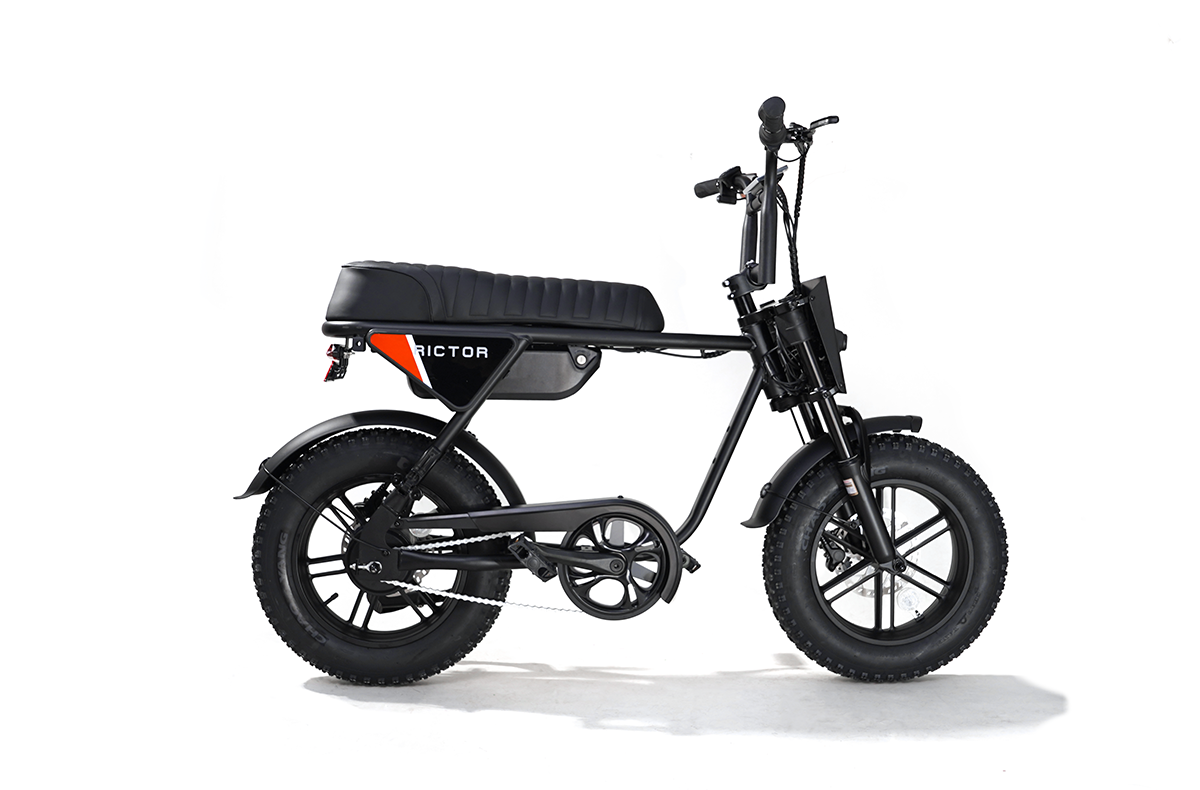
What Exactly Does Pedal Assist Do On Electric Bike?
Among the most important features of these bikes is the pedal assist system, which helps riders maintain speed and reduce effort without entirely relying on a throttle bicycle system.
Whether you're considering a pedelec bike or exploring the benefits of electric bike throttle control, understanding how pedal assist works is essential.
In this guide, we will cover how pedal assist operates, compare it with throttle-controlled e-bikes, and explore its impact on riding performance and efficiency.
1. Basics of Pedal Assist
A pedal assist electric bike (pedelec bike) uses sensors to monitor your pedaling and provide proportional motor support.
As you begin pedaling, the pas sensor detects the rotation and speed of the pedals.
This triggers the motor to assist based on your effort, making it easier to maintain speed on difficult terrains.
This system is distinct from a throttle bicycle, where the motor engages independently of the rider’s pedaling.
The electric bike throttle control system allows for smoother acceleration, making rides more enjoyable for long distances or steep climbs.
What exactly does pedal assist do on an electric bike?
On an electric assist bike, pedal assist ensures that your physical effort is supported by the motor, reducing strain on your body.
This is particularly helpful on power assist bikes, which offer multiple levels of assistance to match different riding conditions.
You can customize the motor support, whether you’re cycling through flat terrain or climbing steep hills.
Unlike electric and pedal bikes that rely solely on motor power, pedal assist bikes enhance your pedaling efficiency, making cycling less strenuous while still giving you the workout benefits.
The pedal assist mode on an e-bike works by coordinating between the pas sensor and the bike’s controller.
The sensor tracks your pedal speed, and the controller adjusts the motor output accordingly.
Many pedelec bicycles feature additional sensors that measure torque or pedal pressure to offer even more precise assistance.
This makes electric assist bicycles feel intuitive to ride because the motor’s power adjusts seamlessly based on your effort. In contrast, a throttle-controlled e-bike allows you to power the bike without pedaling, giving you full control via the throttle handle.
Which Electric Bikes Have the Best Pedal Assist?
The Rictor K1 is the Winner! >>>

| Max Speed (Electric Mode) | 20 mph |
| Max Speed (Pedal Assist Mode) | 28 mph |
| Range (Electric Mode) | 35 miles |
| Range (Pedal Assist Mode) | 70+ miles |
| Rated Power | 750W |
| Voltage | 48V |
| Battery Capacity | 15Ah |
| Charging Current | 3A |
| Peak Torque | 85Nm |
Pros:
- Dual Batteries - Longer rides.
- Intelligent Control System - Smart adjustments.
- Long Range Capability - 70+ miles range.
- High Efficiency - 750W power.
Cons:
- Rear Rack Required - Need extra rack for more cargo.
2. Comparison of Different Modes and Systems
The primary difference between an electric bike and an electric assist bike is how the motor is engaged.
In a fully electric bike, the rider can use the throttle of motorcycle-style control to power the bike without pedaling, functioning much like a scooter.
On the other hand, an electric assist bike requires you to pedal for the motor to engage, which offers a more interactive cycling experience.
Electric bikes with throttle control are excellent for riders who prefer less effort, while pedelec bikes give riders the option to still engage physically while receiving support from the motor.
What’s the difference between pedal assist and throttle mode?
Pedal assist and throttle mode differ significantly in how they interact with the rider.
In pedal assist mode, the motor only engages when you’re actively pedaling, making it a collaborative effort between the rider and the bike.
This is commonly found on e-bikes with throttle and pedal assist, giving riders a balance between manual power and motor assistance.
In contrast, throttle mode allows you to control the motor power directly through a throttle control ebike system, which doesn’t require any pedaling.
This system, similar to a throttle on a motorcycle, offers convenience but may consume more battery power since it relies entirely on the motor for propulsion.

3. Riding Experience and Value
Are pedal assist bikes worth it?
Rictor K1 dual battery vinatge electric bike with beat pedal assist system maks riding easier!
Pedal assist bikes are definitely worth it for riders.
These bikes, such as specialized pedal assist bikes, offer a unique riding experience where you can enjoy the fitness benefits of cycling while reducing fatigue.
Whether you’re commuting to work or taking on long-distance rides, the ability to adjust motor support makes pedal assist bikes versatile.
Additionally, many riders find that electric assist bicycles are more energy-efficient than throttle-controlled e-bikes, as the motor only works when needed, conserving battery life.
This is especially important for riders who want to cover longer distances without worrying about the battery running out too soon.
Can you ride an ebike without pedal assist?
Absolutelly!
Most e-bikes, including pedal assist electric bikes, come with the option to turn off the motor and ride manually, just like a traditional bike.
Some e-bikes include a throttle-only ebike mode, where you can control the bike’s speed with the throttle instead of pedaling.
This mode is ideal for riders who need a break from pedaling or want to cruise at a constant speed without effort.
However, relying solely on the throttle may drain the battery faster compared to using pedal assist, which balances motor power with human effort.
4. Adjustments and Battery Efficiency
Most e-bikes come with multiple levels of pedal assist, typically ranging from three to five levels.
These settings allow you to adjust the motor's support based on your riding needs.
For example, lower levels of electric bike pedal assist are ideal for flat terrain, offering minimal motor support to conserve battery life.
Higher levels provide maximum assistance, perfect for tackling hills or riding against strong headwinds.
Whether you're riding a peddle assist bike or a throttle assist electric bike, having the ability to control the motor output ensures a comfortable and efficient ride.
Pedal assist e-bikes let you to adjust the strength of the motor’s assistance during your ride.
Using a handlebar-mounted display, you can easily switch between different assist levels based on the terrain or your energy level.
If you're climbing a steep hill, you can increase the assist level for more power.
Conversely, on flat roads, you might choose a lower setting to conserve battery. This flexibility makes bikes with pedal assist highly adaptable to various riding conditions, ensuring that you have the right amount of motor support when you need it most.
Pedal assist can significantly improve battery efficiency compared to throttle-controlled e-bikes.
Because the motor only activates when you're pedaling, it uses less energy than a throttle-only electric bike, where the motor is constantly engaged.
By allowing the rider to contribute physical power, electric pedal assist bicycles can extend the battery’s range, making them more efficient for long-distance rides.
Additionally, riders can switch to a lower assist mode or turn off the motor entirely on flat terrain, further conserving battery life.
This makes pedal assist bicycles a popular choice for those who want to maximize both performance and efficiency.
5. Impact on Speed and Terrain
Pedal assist plays a significant role in determining the speed of an electric bike. With higher levels of assist, the motor provides more power, allowing you to reach higher speeds with less effort.
On flat terrain, this can result in a smooth, fast ride, especially on pedelec bicycles where the motor output is directly tied to your pedaling.
However, riders can also limit their speed by selecting lower assist levels, which provide enough power for a comfortable pace without over-exerting the motor.
This adaptability makes electric assist bikes ideal for both casual rides and high-speed commuting, allowing riders to tailor the bike’s performance to their preferences.
Riding uphill can be challenging, but pedal assist makes it significantly easier. When climbing steep hills, the motor kicks in to provide extra torque, helping you maintain speed without burning out your legs.
This is especially useful on pedal assist electric bicycles, where the motor provides just enough power to keep you moving smoothly without requiring you to exert maximum effort.
On higher assist levels, the bike can handle even the steepest inclines, making it easier to conquer challenging terrain.
This feature is one of the main reasons why riders choose e-bikes with throttle and pedal assist, as it provides both flexibility and ease in diverse environments.
Conclusion
In conclusion, pedal assist electric bikes offer a balanced combination of manual pedaling and motorized support, making them an excellent choice for riders of all experience levels.
Whether you're using a pedelec bike or a throttle assist ebike, understanding the features of pedal assist can help you get the most out of your ride.
From improving battery efficiency to conquering hills with ease, the benefits of pedal assist bicycles are clear.
As you explore the world of e-bikes, consider how pedal assist can enhance your cycling experience, providing both convenience and performance.
FAQs
How long does an e-bike battery last before it needs to be replaced?
The lifespan of an e-bike battery typically ranges from 2 to 5 years, depending on the type of battery, how frequently you ride, and how well you maintain it. Proper charging habits, such as not overcharging and avoiding complete discharges, can help extend battery life.
Can I upgrade my e-bike’s battery for longer range?
In many cases, yes. Some e-bike manufacturers offer higher capacity batteries as upgrades. However, ensure that the upgraded battery is compatible with your bike’s motor and controller to avoid performance issues.
What is the difference between a mid-drive and hub motor in e-bikes?
Mid-drive motors are positioned near the bike’s pedals and provide power directly to the chain, making them efficient for hill climbing and balanced weight distribution. Hub motors are located in the wheels and provide direct propulsion, making them simpler but less efficient for steep terrains.



